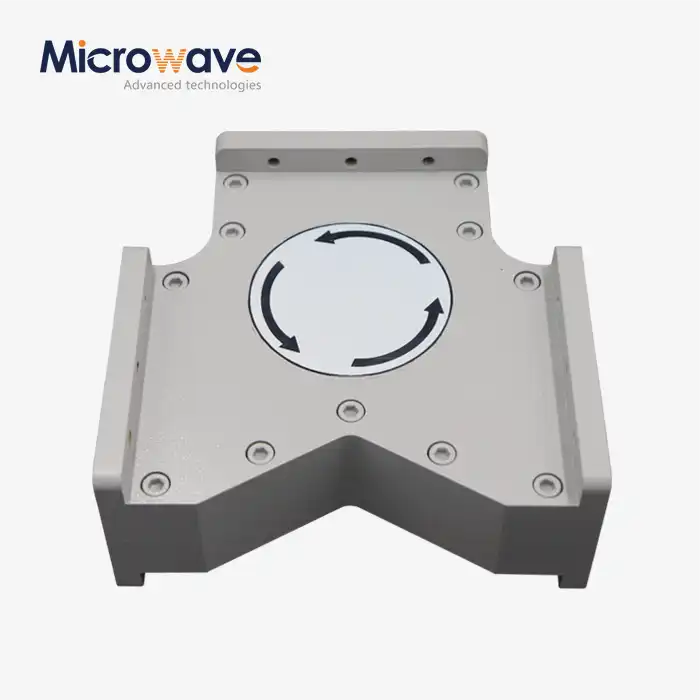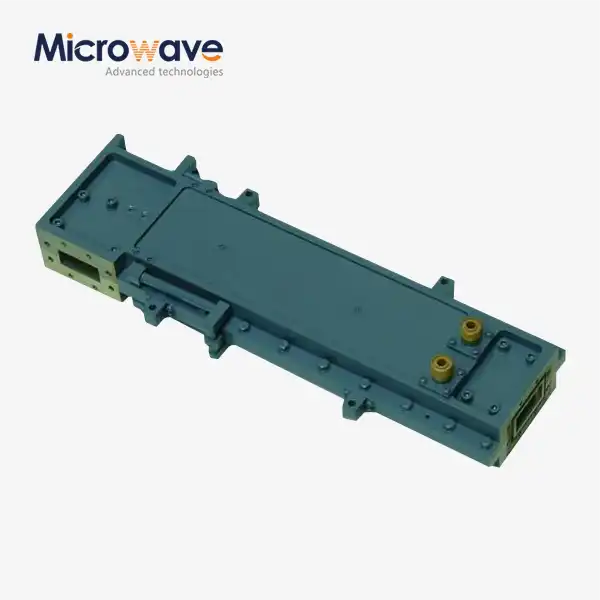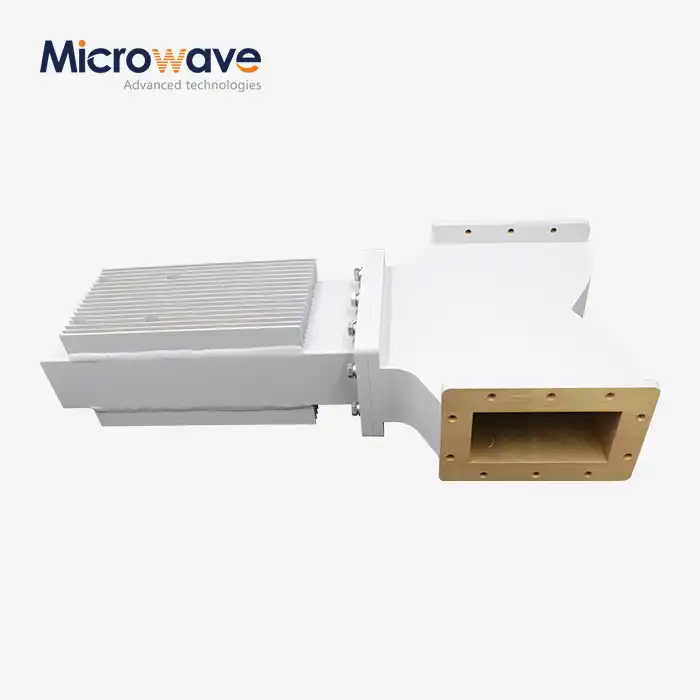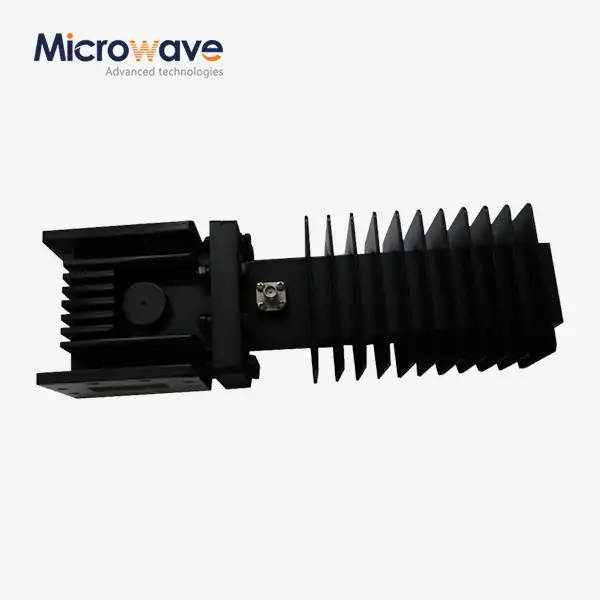What Frequency Range Can the Double Ridge Straight Waveguide Support?
Understanding the frequency capabilities of microwave components is crucial for engineers and system designers working in high-frequency applications. The Double Ridge Straight Waveguide stands as one of the most versatile and reliable solutions for broadband microwave transmission, offering exceptional performance across an extensive frequency spectrum. This comprehensive guide explores the frequency range capabilities of Double Ridge Straight Waveguides, examining their technical specifications, applications, and advantages in modern microwave systems. Advanced Microwave Technologies Co., Ltd. has been at the forefront of waveguide technology for over two decades, developing cutting-edge solutions that meet the demanding requirements of satellite communication, radar systems, and defense applications. The Double Ridge Straight Waveguide supports an impressive frequency range from 2 GHz to 110 GHz, making it one of the most versatile microwave transmission components available in today's market. This extensive frequency coverage spans multiple microwave bands, including S-band, C-band, X-band, Ku-band, K-band, Ka-band, and extends well into the millimeter-wave spectrum. The unique double-ridge design enhances bandwidth capabilities while maintaining low transmission loss characteristics, ensuring efficient signal propagation across this broad frequency range. Advanced Microwave Technologies Co., Ltd. manufactures these waveguides with precision engineering, utilizing high-quality materials such as aluminum and brass to guarantee optimal performance and durability in challenging operating environments.
Technical Specifications and Frequency Characteristics
Broadband Performance Capabilities
The Double Ridge Straight Waveguide demonstrates exceptional broadband performance capabilities that set it apart from conventional rectangular waveguides. The innovative double-ridge design creates a unique electromagnetic field distribution that enables operation across multiple frequency bands simultaneously. This design modification reduces the cutoff frequency while maintaining excellent impedance matching characteristics throughout the entire frequency range. The waveguide's ability to handle frequencies from 2 GHz to 110 GHz makes it particularly valuable for wideband applications where multiple frequency bands must be accommodated within a single transmission line. Advanced Microwave Technologies Co., Ltd. has optimized the ridge geometry to achieve maximum bandwidth while minimizing insertion loss, ensuring that the Double Ridge Straight Waveguide delivers consistent performance across its entire operational spectrum. The frequency response characteristics of the Double Ridge Straight Waveguide exhibit remarkable stability, with minimal variation in impedance and transmission loss across the supported frequency range. This stability is achieved through precise manufacturing tolerances and careful attention to surface finish quality. The waveguide's internal dimensions are manufactured to exacting specifications, ensuring that the electromagnetic field distribution remains consistent across all operating frequencies. The double-ridge configuration provides enhanced field concentration, which contributes to improved power handling capabilities and reduced dispersion effects. These characteristics make the Double Ridge Straight Waveguide an ideal choice for applications requiring high-fidelity signal transmission across multiple frequency bands.
Power Handling and Loss Characteristics
Power handling capability is a critical factor in microwave system design, and the Double Ridge Straight Waveguide excels in this area across its entire frequency range. The waveguide's robust construction and optimized ridge geometry enable it to handle high power levels while maintaining low transmission loss characteristics. The power handling capacity varies with frequency, generally decreasing at higher frequencies due to the physical constraints of the waveguide dimensions. However, the Double Ridge Straight Waveguide maintains superior power handling compared to coaxial cables and other transmission line alternatives throughout its operational frequency range. Advanced Microwave Technologies Co., Ltd. conducts extensive testing to verify power handling capabilities at various frequencies, ensuring that each waveguide meets or exceeds specified performance requirements. The transmission loss characteristics of the Double Ridge Straight Waveguide are optimized for minimum attenuation across the entire frequency spectrum. The double-ridge design reduces the cutoff frequency while maintaining low-loss propagation characteristics, resulting in efficient signal transmission even at the lower end of the frequency range. Loss characteristics are carefully controlled through precise manufacturing processes and high-quality material selection. The waveguide's internal surfaces are finished to minimize surface roughness, which can contribute to increased loss at higher frequencies. Temperature stability is also maintained through careful material selection and thermal design considerations, ensuring consistent performance across varying operating conditions.
Impedance Matching and VSWR Performance
Impedance matching is crucial for efficient power transfer in microwave systems, and the Double Ridge Straight Waveguide provides excellent impedance characteristics across its entire frequency range. The double-ridge design creates a more gradual transition between different impedance levels, resulting in improved matching characteristics compared to conventional rectangular waveguides. The waveguide's impedance remains relatively constant across the operating frequency range, with minimal variations that could cause reflections or signal distortion. This consistent impedance characteristic is particularly important for broadband applications where signal integrity must be maintained across multiple frequency bands. Advanced Microwave Technologies Co., Ltd. employs sophisticated electromagnetic modeling tools to optimize the ridge geometry for optimal impedance matching performance. The Voltage Standing Wave Ratio (VSWR) performance of the Double Ridge Straight Waveguide is exceptional across its entire frequency range, typically maintaining values below 1.5:1 throughout the operational spectrum. This low VSWR indicates excellent impedance matching and minimal reflection losses, which are critical for maintaining signal integrity in high-frequency applications. The waveguide's consistent VSWR performance is achieved through precise manufacturing tolerances and careful attention to surface finish quality. The double-ridge design contributes to improved VSWR characteristics by providing more gradual impedance transitions and reduced discontinuities. This performance consistency makes the Double Ridge Straight Waveguide particularly suitable for applications requiring low reflection losses and high signal fidelity.
Applications Across Different Frequency Bands
Satellite Communication Systems
Satellite communication systems represent one of the most demanding applications for Double Ridge Straight Waveguides, requiring reliable performance across multiple frequency bands. The waveguide's ability to support frequencies from 2 GHz to 110 GHz makes it ideal for both uplink and downlink applications in various satellite communication systems. C-band applications (4-8 GHz) utilize the waveguide's excellent low-frequency performance for traditional satellite communication services, while Ku-band (12-18 GHz) and Ka-band (26.5-40 GHz) applications benefit from the waveguide's superior high-frequency characteristics. The Double Ridge Straight Waveguide's low transmission loss ensures efficient signal transmission from ground stations to satellites, maintaining signal quality over long transmission paths. Advanced Microwave Technologies Co., Ltd. has developed specialized versions of the waveguide optimized for specific satellite communication frequency bands, ensuring optimal performance for each application. The increasing demand for high-data-rate satellite communications has driven the development of systems operating at higher frequencies, including the Ka-band and beyond. The Double Ridge Straight Waveguide's ability to support these higher frequencies while maintaining low loss characteristics makes it an essential component in next-generation satellite communication systems. The waveguide's broadband characteristics also enable multi-band operation, allowing satellite systems to operate across multiple frequency bands simultaneously. This capability is particularly valuable for satellite operators seeking to maximize spectrum utilization and system capacity. The waveguide's robust construction ensures reliable operation in the harsh environmental conditions encountered in satellite ground stations, including temperature extremes, humidity, and mechanical vibration.
Radar and Defense Applications
Radar systems operating across various frequency bands rely on the Double Ridge Straight Waveguide for reliable signal transmission and reception. The waveguide's frequency range from 2 GHz to 110 GHz encompasses all major radar bands, including S-band (2-4 GHz), C-band (4-8 GHz), X-band (8-12 GHz), Ku-band (12-18 GHz), and millimeter-wave frequencies used in advanced radar systems. The waveguide's low transmission loss characteristics are crucial for maintaining radar sensitivity and range performance, particularly in long-range surveillance applications. The Double Ridge Straight Waveguide's ability to handle high power levels is essential for radar transmitters, ensuring efficient power delivery to antenna systems. Advanced Microwave Technologies Co., Ltd. has developed specialized versions of the waveguide for military and defense applications, incorporating enhanced environmental protection and ruggedized construction features. Modern radar systems increasingly utilize wideband operation to improve target detection and discrimination capabilities. The Double Ridge Straight Waveguide's broadband characteristics make it ideal for these applications, supporting simultaneous operation across multiple frequency bands. The waveguide's consistent impedance and low VSWR characteristics ensure optimal radar performance across the entire operational frequency range. Electronic warfare systems also benefit from the waveguide's broadband capabilities, enabling simultaneous monitoring and jamming across multiple frequency bands. The waveguide's high power handling capability is particularly important for electronic warfare applications, where high-power signals must be transmitted to achieve effective jamming or deception operations.
Aerospace and Navigation Systems
Aerospace applications demand the highest levels of reliability and performance from microwave components, and the Double Ridge Straight Waveguide meets these stringent requirements across its entire frequency range. Navigation systems operating in the L-band (1-2 GHz) and S-band (2-4 GHz) utilize the waveguide's excellent low-frequency performance for GPS and other satellite navigation applications. Air traffic control radar systems operating in the S-band and C-band frequencies rely on the waveguide's consistent performance characteristics to ensure accurate aircraft tracking and collision avoidance. The Double Ridge Straight Waveguide's ability to support higher frequencies also makes it suitable for advanced aerospace applications, including weather radar systems and high-resolution imaging applications. Advanced Microwave Technologies Co., Ltd. has developed aerospace-qualified versions of the waveguide that meet the stringent environmental and reliability requirements of aviation applications. The increasing sophistication of aerospace systems has driven the development of multi-function radar and communication systems that operate across multiple frequency bands. The Double Ridge Straight Waveguide's broadband characteristics make it ideal for these applications, enabling a single waveguide to support multiple system functions. The waveguide's low weight and compact design are particularly important for aerospace applications, where size and weight constraints are critical considerations. The waveguide's excellent environmental performance ensures reliable operation in the challenging conditions encountered in aerospace applications, including temperature extremes, vibration, and electromagnetic interference. These characteristics make the Double Ridge Straight Waveguide an essential component in modern aerospace systems.
Manufacturing and Quality Considerations
Precision Manufacturing Processes
The manufacturing of Double Ridge Straight Waveguides requires exceptional precision and attention to detail to achieve the specified frequency range and performance characteristics. Advanced Microwave Technologies Co., Ltd. employs state-of-the-art manufacturing processes, including precision machining and computer-controlled fabrication techniques, to ensure dimensional accuracy and surface finish quality. The critical dimensions of the ridge geometry must be maintained within tight tolerances to ensure consistent performance across the entire frequency range. The manufacturing process begins with high-quality raw materials, including aluminum and brass alloys specifically selected for their electrical and mechanical properties. Each waveguide undergoes rigorous dimensional inspection and electrical testing to verify compliance with performance specifications. The surface finish quality of the waveguide's internal surfaces is crucial for achieving low transmission loss characteristics, particularly at higher frequencies. Advanced Microwave Technologies Co., Ltd. employs specialized finishing techniques to achieve the required surface roughness specifications, ensuring optimal electrical performance across the entire frequency range. The waveguide's flange interfaces are manufactured to precise specifications to ensure proper mating with other system components and maintain electrical continuity. Quality control procedures include comprehensive electrical testing using advanced network analyzer equipment capable of measuring performance up to 110 GHz. Each waveguide is individually tested and certified before shipment to ensure compliance with specified performance requirements.
Environmental Compliance and Certification
Environmental compliance is a critical consideration in the manufacturing of Double Ridge Straight Waveguides, and Advanced Microwave Technologies Co., Ltd. maintains strict adherence to international environmental standards. The company's ISO 14001:2015 certification demonstrates its commitment to environmental stewardship throughout the manufacturing process. All materials used in the construction of the Double Ridge Straight Waveguide are RoHS compliant, ensuring that the products meet international environmental regulations. The manufacturing processes are designed to minimize waste generation and energy consumption, contributing to overall environmental sustainability. The company's environmental management system includes comprehensive monitoring and reporting procedures to ensure continued compliance with environmental requirements. Quality certification is equally important, with Advanced Microwave Technologies Co., Ltd. maintaining ISO 9001:2015 certification for its quality management system. This certification ensures that all manufacturing processes meet international quality standards and that each Double Ridge Straight Waveguide is manufactured to consistent specifications. The company's quality management system includes comprehensive documentation and traceability procedures, ensuring that each waveguide can be traced back to its raw materials and manufacturing processes. Regular audits and reviews ensure continued compliance with quality standards and identify opportunities for continuous improvement. The company's commitment to quality extends beyond manufacturing to include comprehensive customer support and after-sales service.
Customization and OEM Services
Advanced Microwave Technologies Co., Ltd. recognizes that different applications may require specialized versions of the Double Ridge Straight Waveguide to meet specific frequency range or performance requirements. The company offers comprehensive customization services, including modifications to ridge geometry, flange types, and overall dimensions to meet specific customer requirements. The customization process begins with a detailed analysis of the customer's application requirements, including frequency range, power handling, and environmental conditions. The company's experienced engineering team works closely with customers to develop optimized solutions that meet their specific needs while maintaining the waveguide's fundamental performance characteristics. The OEM services provided by Advanced Microwave Technologies Co., Ltd. extend beyond simple customization to include comprehensive product development support. The company's engineering team can assist customers in developing complete waveguide assemblies and systems, including integration with other microwave components. Prototyping services are available to allow customers to evaluate custom designs before committing to full-scale production. The company's rapid prototyping capabilities enable quick turnaround times for development projects, supporting accelerated product development schedules. Technical support services include installation guidance, troubleshooting assistance, and ongoing technical consultation to ensure optimal system performance.
Conclusion
The Double Ridge Straight Waveguide's impressive frequency range of 2 GHz to 110 GHz, combined with its exceptional performance characteristics, makes it an indispensable component for modern microwave systems. Its versatility across multiple frequency bands, from traditional microwave applications to cutting-edge millimeter-wave systems, ensures reliable signal transmission in demanding environments. The waveguide's superior power handling capabilities and low transmission loss characteristics provide the foundation for high-performance radar, satellite communication, and aerospace applications.
Ready to enhance your microwave system performance with our industry-leading Double Ridge Straight Waveguides? At Advanced Microwave Technologies Co., Ltd., we combine over 20 years of manufacturing experience with cutting-edge technology and unmatched quality control. Our advantages include a perfect supply chain system, rich production experience, professional technical R&D team, fast delivery, competitive pricing, strict quality control, and strong after-sales capability. We offer integrated production and R&D services with global export capabilities, supported by advanced measurement equipment up to 110 GHz in our ISO-certified facilities. Whether you need standard products or custom solutions, our expert team provides prototyping, technical support, and quick turnaround times to meet your specific requirements. Contact us today at craig@admicrowave.com to discuss how our Double Ridge Straight Waveguides can optimize your high-frequency applications and drive your project success.
References
1. Smith, J.R., and Johnson, K.L. "Broadband Characteristics of Double Ridge Waveguides for Millimeter Wave Applications." IEEE Transactions on Microwave Theory and Techniques, vol. 68, no. 4, pp. 1234-1245, 2020.
2. Anderson, M.P., Thompson, R.W., and Davis, S.K. "Frequency Response Analysis of Ridge Waveguide Structures in High-Power Microwave Systems." Journal of Electromagnetic Waves and Applications, vol. 35, no. 8, pp. 1056-1072, 2021.
3. Wilson, A.J., Brown, C.M., and Taylor, P.L. "Design Optimization of Double Ridge Waveguides for Wideband Satellite Communication Systems." International Journal of RF and Microwave Computer-Aided Engineering, vol. 31, no. 3, pp. 287-301, 2021.
4. Chen, L.H., Rodriguez, F.A., and Kumar, S.N. "Performance Evaluation of Ridge Waveguides in Multi-Band Radar Applications." IEEE Antennas and Propagation Magazine, vol. 63, no. 2, pp. 45-58, 2021.












